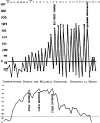Evidence and implications of mortality associated with acute Plasmodium vivax malaria
- PMID: 23297258
- PMCID: PMC3553673
- DOI: 10.1128/CMR.00074-12
Evidence and implications of mortality associated with acute Plasmodium vivax malaria
Abstract
Vivax malaria threatens patients despite relatively low-grade parasitemias in peripheral blood. The tenet of death as a rare outcome, derived from antiquated and flawed clinical classifications, disregarded key clinical evidence, including (i) high rates of mortality in neurosyphilis patients treated with vivax malaria; (ii) significant mortality from zones of endemicity; and (iii) the physiological threat inherent in repeated, very severe paroxysms in any patient, healthy or otherwise. The very well-documented course of this infection, with the exception of parasitemia, carries all of the attributes of "perniciousness" historically linked to falciparum malaria, including severe disease and fatal outcomes. A systematic analysis of the parasite biomass in severely ill patients that includes blood, marrow, and spleen may ultimately explain this historic misunderstanding. Regardless of how this parasite is pernicious, recent data demonstrate that the infection comes with a significant burden of morbidity and associated mortality. The extraordinary burden of malaria is not heavily weighted upon any single continent by a single species of parasite-it is a complex problem for the entire endemic world, and both species are of fundamental importance. Humanity must rally substantial resources, intellect, and energy to counter this daunting but profound threat.
Figures






References
-
- Mendis K, Sina BJ, Marchesini P, Carter R. 2001. The neglected burden of Plasmodium vivax malaria. Am. J. Trop. Med. Hyg. 64:97–106 - PubMed
-
- Guerra CA, Howes RE, Patil AP, Gething PW, Van Boeckel TP, Temperley WH, Kabaria CW, Tatem AJ, Manh BH, Elyazar IR, Baird JK, Snow RW, Hay SI. 2010. The international limits and population at risk of Plasmodium vivax transmission in 2009. PLoS Negl. Trop. Dis. 4:e774 doi:10.1371/journal.pntd.0000774 - DOI - PMC - PubMed
-
- Gething PW, Elyazar IRF, Moyes CL, Smith DL, Battle KE, Guerra CA, Patil AP, Tatem AJ, Howes RE, Myers MF, George DB, Horby P, Wertheim HFL, Price RN, Müeller I, Baird JK, Hay SI. 2012. A long neglected world malaria map: Plasmodium vivax endemicity in 2010. PLoS Negl. Trop. Dis. 6:e1814 doi:10.1371/journal.pntd.0001814 - DOI - PMC - PubMed
Publication types
MeSH terms
Grants and funding
LinkOut - more resources
Full Text Sources
Other Literature Sources
Medical

